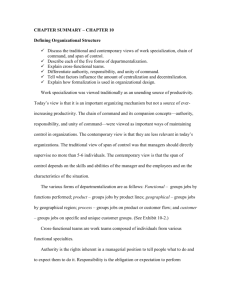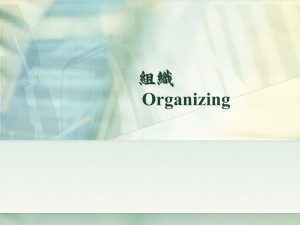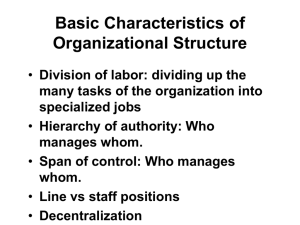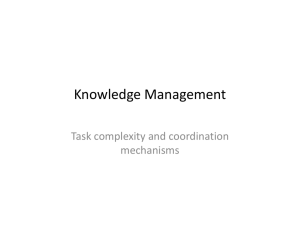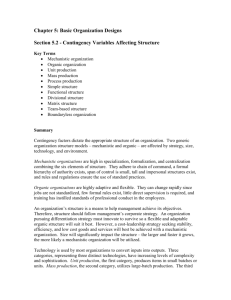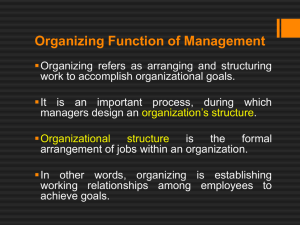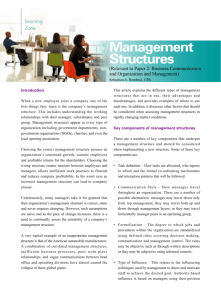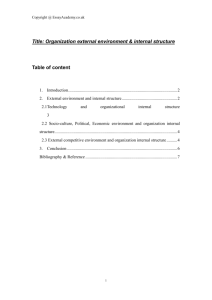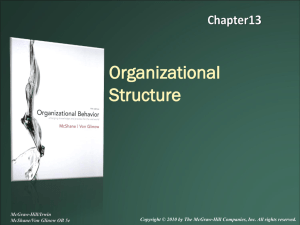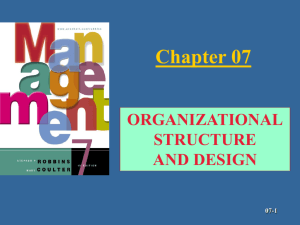Organization Structure and Design
advertisement
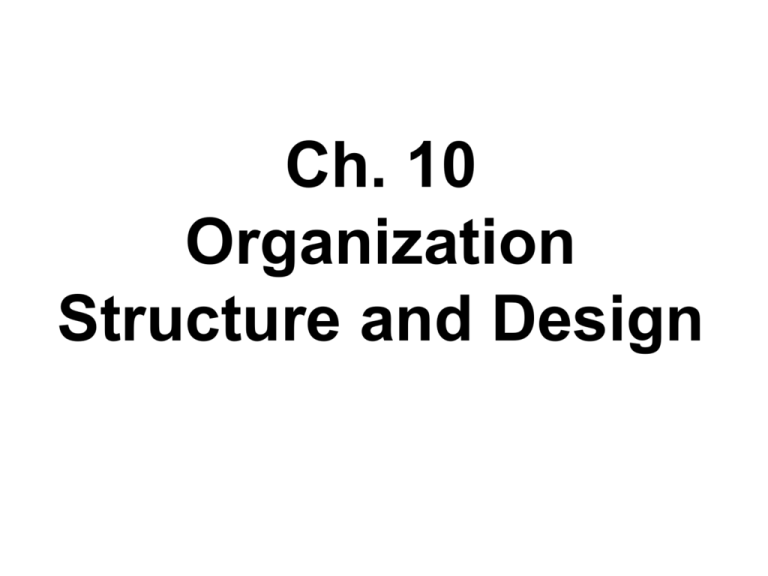
Ch. 10 Organization Structure and Design Learning Objectives • Organization structure and design • Work specialization – traditional and contemporary views • Five types of departmentalization • Cross-functional teams • Chain of command, authority, responsibility, unity of command • Span of control • Centralization vs. decentralization • Formalization • Mechanistic vs. organic designs • Relationship between strategy and structure • Organizational size and structure • Technology and structure • Environmental uncertainty and structure • Simple, functional, divisional, matrix, team-based structures What Type of Organizational Structure Do You Prefer? I prefer to work in an organization where: 1. 2. 3. 4. 5. 6. 7. 8. 9. 10. 11. 12. 13. 14. 15. 1 = Strongly disagree 2 = Inclined to disagree 3 = Neither agree or disagree 4 = Inclined to agree 5 = Strongly agree Goals are defined by those at higher levels. Clear job descriptions exist for every job. Top management makes important decisions. Promotions and pay increases are based as much on length of service as on level of performance. Clear lines of authority and responsibility are established. My career is pretty well planned out for me. 1 have a great deal of job security. I can specialize. My boss is readily available. Organization rules and regulations are clearly specified. Information rigidly follows the chain of command. There is a minimal number of new tasks for me to learn. Work groups incur little turnover in members. People accept authority of a leader's position. I am part of a group whose training and skills are similar to mine. What Type of Organizational Structure Do You Prefer? 60 – you prefer a mechanistic design Below 45 – you prefer organic design Between 45 and 60 – no clear preference Remember which you prefer! Organization Structure Organization Design The formal The process of arrangement developing or of jobs within changing an an organization’s organization structure Elements of Organizational Design • Work specialization • Departmentalization • Chain of command • Span of control • Centralization and decentralization • Formalization Specialization • To what degree are activities divided into separate jobs? • Traditional vs. contemporary views Departmentalization – Five Types Line Authority: The Chain of Command Chief Executive Officer Executive Vice President Vice President Vice President Region 1 District A District B Region 2 District C President Vice President Region 3 District D Executive Vice President Vice President Region 4 District E Vice President Region 5 District F District G Contrasting Spans of Control Members at Each Level Organization Level (Highest) Assuming Span of 4 Assuming Span of 8 1 1 1 2 4 8 3 16 64 4 64 512 5 256 4,096 6 1,024 7 4,096 (Lowest) Span of 4: Span of 8: Operatives: = 4,096 Operatives: = 4,096 Managers (levels 1-6) = 1,365 Managers (levels 1-4) = 585 Centralized vs. Decentralized Structures Formalization • How standardized are the jobs? • How much discretion do employees have? • How “rule-bound” are people? What Type of Organizational Structure Do You Prefer? Scoring • Scores above 60 suggest that you prefer a mechanistic design (stable, ruleoriented, more bureaucratic organizations). • Scores below 45 indicate a preference for an organic design (small, innovative, flexible, team-oriented organizations. • Scores between 45 and 60 suggest no clear preference. Recent trend has been toward more organic designs. But, are few pure organic structures. Many organizations are somewhat bureaucratic. Very low score – you may be frustrated by overly rigid structures of rules, regulations, and boss-centered leadership Very high score – you may be frustrated by loose, informal, vague, boss-less organization Mechanistic vs. Organic Organizations • • • • • • • • High specialization Rigid departmentalization Clear chains of command Narrow spans of control Highly centralized Highly formalized “Bureaucracy” “Well-oiled machine” • • • • • • • • Cross-functional teams Cross-hierarchical teams Free flow of information Wide spans of control Decentralized Low formalization “Adhocracy” Adaptable “amoeba” Strategy Contingency Factors and Organization Design Environmental Uncertainty Size Technology Strategy and Structure Strategy • Cost minimizers • Differentiation (innovation) • Imitator Structure • Mechanistic • Organic • Both Size and Structure Mechanistic Structure Organic 10 300 500 2000 Size 2500 Environmental Uncertainty and Structure Environment • Stable, simple environment • Unstable, complex environment Structure • Mechanistic structure • Organic structure Technology and Structure Italian suits, furniture restoration, high-tech Structure Organic Mechanistic Oil, chemicals, beer, water filtration Autos, computers Mass Process Technology Unit Design Your Restaurant (the one that will make you rich and famous) • • • • • • • • • • Environment – stable vs. uncertain (Who is your clientele? How stable are their tastes? Strategy? – cost, differentiator, both? Technology? Mass, batch? Size? – how many employees? Span of control? How many employees per manager? Specialization? What job titles? How many? How narrow/specialized will each job title be? Chain of command? – Who will report to who? How many bosses Centralization/decentralization – Who will make decisions? What decisions will they make? Formalization? How strict/rule-bound will the organization be? What will the rules be? Overall - Organic or mechanistic? Some Popular Types of Structures Simple Functional Divisional Team Matrix Project Simple Structure Low departmentalization Wide spans of control Commonly used by small businesses Strengths Fast, flexible, inexpensive, clear accountability Weaknesses Impractical as organizational grows Reliance on one person risky Functional Structure Groups occupational specialties (functions) together Strengths Economies of scale Weaknesses Formation of functional “silos” that lose sight of what’s best for organization overall Divisional Structure Separate business units or divisions All functions under one roof Each has P/L responsibility Strengths Focused on results Weaknesses Duplication of activities and resources Team Structure Entire organization made up of work teams Employee empowerment crucial Authority rests in team, not chain of command Strengths: Employees more involved and empowered Reduced barriers among functional areas Weaknesses No clear chain of command Pressure on teams to perform Can take YEARS to develop! Matrix Structure Matrix Structures Specialists from functions work on projects as needed Dual chain of command – two managers! Strengths Better use of resources Fluid and flexible Weaknesses Complexity of having two bosses Project Structures No formal departments Employees jump from project to project! Fluid and flexible Santa Clara Division Restructuring GM R&D Mktg. GM Lasers Manuf. Clocks R&D Mktg. Manuf. Before After Counters
